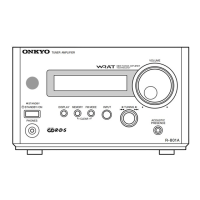
Do you have a question about the Onkyo R-801A and is the answer not in the manual?
| Power output | 40 watts per channel (8 ohms, 20Hz-20kHz, 0.08% THD) |
|---|---|
| Frequency response | 5Hz-100kHz (+1dB, -3dB) |
| Input sensitivity | 2.5mV (MM), 150mV (line) |
| Signal to noise ratio | 80dB (MM), 102dB (line) |
| Dimensions | 430 x 145 x 330 mm (W x H x D) |
| Weight | 8.2kg |
| Speaker load impedance | 4-16 ohms |
| Type | Stereo |
Essential safety instructions for operation, electrical shock prevention, and handling.
Guidelines for safe installation, ventilation, placement, and servicing procedures.
Information on recording copyright, AC fuse details, and unit care instructions.
Critical warnings and advice regarding power voltage, connection, and potential surges.
Details on FCC regulations for radio frequency energy and Canadian ICES-003 compliance.
Summary of the key technical specifications and functionalities of the R-801A.
A list of all included accessories for user verification.
Instructions for connecting the R-801A with other ONKYO Separate Collection Series components.
Examples of physical stacking arrangements for ONKYO system components.
Guidance on making audio connections using RCA and optical cables.
Procedures for connecting RI control and AC power outlets between components.
How to connect non-ONKYO audio/video devices to the unit.
Guide on connecting a subwoofer, with or without a separate amplifier.
Details on establishing RI system connections for unified remote control.
Step-by-step instructions for connecting speakers to the amplifier terminals.
Instructions for connecting the AM loop and outdoor antennas.
Guidance on connecting indoor and outdoor FM antennas for optimal reception.
How to connect antenna cables using the 75/300 ohm adapter.
Instructions for installing batteries and using the remote controller effectively.
Proper procedure for connecting the unit to a power source and notes on power surge.
How to set the clock automatically using RDS signals (European models).
Procedure to check or change the RDS station used for automatic clock adjustment.
Step-by-step guide to manually set the clock time and day of the week.
How to display the current time using the CLOCK button.
How to select the desired audio input source and adjust volume levels.
Details on using the Acoustic Presence feature to enhance sound quality.
Instructions for muting audio and connecting headphones for private listening.
Steps for preparing and executing audio recording from selected sources.
How to manually tune FM and AM radio frequencies.
Automatically scans and stores the strongest FM stations into memory.
Guide on storing specific radio stations into preset memory locations.
How to recall previously stored radio stations using preset numbers.
How to tune into stereo FM stations and switch to mono if needed.
Procedure to erase stored radio stations from the preset memory.
Instructions for assigning custom names to preset radio stations.
How to modify or rename previously entered preset station names.
Method to delete all custom names stored for preset stations.
Explains RDS features like Program Service Name and Radio Text.
How to view Radio Text information transmitted by FM stations.
Summary of timer modes: Playback, Recording, Day Setting, and Clock Adjustment.
Customizing which days are considered weekdays or weekends for timer programming.
Setting the ON time, OFF time, and source for timed playback.
Setting the ON time, OFF time, day, and source for timed recordings.
How to switch programmed timer functions ON or OFF.
Setting a timer to automatically switch the unit to standby after a specified period.
A reference guide linking controls to their operational pages.
Detailed explanation of buttons and functions available on the remote controller.
Common issues like no power, no sound, or remote control problems with their solutions.
Tips for AM/FM reception, tuning indicators, RDS, and ACCUCLOCK issues.
Technical details for the amplifier's power output, distortion, sensitivity, and tone controls.
Includes clock precision, power supply, consumption, dimensions, and weight.
